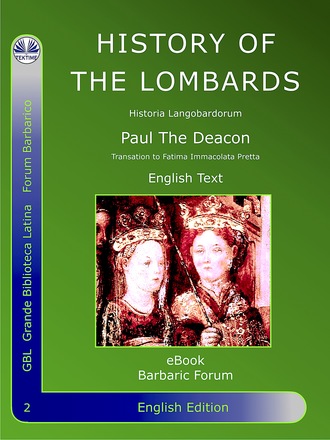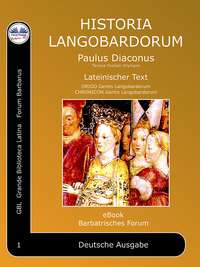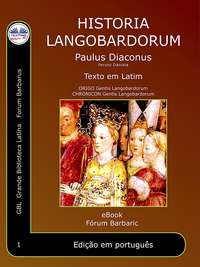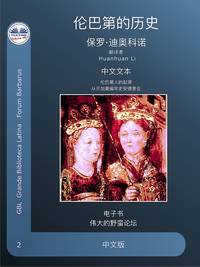
Полная версия
History Of The Lombards

Paul The Deacon
History of the Lombards
Historia Langobardorum
Translated by Fatima Immacolata Pretta
Copyright © 2020 - Paul The Deacon
Published by Tektime
CONTENT OF THE BOOK
The book contains a short preface divided into thematic sections, followed by the Origo Gentis Langobardorum, divided into seven paragraphs which contains the legend of the name and of Scandinavian origins. This is followed by Paolo Diacono's Historia Langobardorum. After Paolo's six books there is Andrea's Chronicon from Bergamo composed of nineteen sections which humbly completes the story of the Historia and makes us know, at least partially, the events that followed the Franca occupation.
GBL CATALOG
e-Books
Foro Barbarico
1 - Historia Langobardorum - Paulus Diaconus - Latino (IT) - ISBN 9788822856029
2 - Storia dei Longobardi - Paolo Diacono - Italiano - ISBN 9788822882547
3 - Edictum Rothari Regis - Scriptorium di Bobbio - Latino (IT) - ISBN 9788827504161
4 - Editto di Rotari - Scriptorium di Bobbio - Italiano - ISBN in lavorazione
5 - Origo Gentis Langobardorum - Re Rotari - ISBN 9788822814661
6 - Chronicon Gentis Langobardorum - Andrea da Bergamo - ISBN 9788822812841
7 - Codicis Gothani - Anonimo cavaliere Franco - ISBN 9788826464893
22 - Costituzione - Giustiniano - Latino - ISBN In lavorazione
23 - Costituzione - Giuistiniano - Italiano - ISBN …
Foro Ellenico
1 - Iliade - Omero - Greco Antico - ISBN 9788832502022
2 - Iliade - Vincenzo Monti - Italiano - ISBN 9788834182192
3 - Odissea - Omero - Greco Antico - ISBN 9788832533460
4 - Odissea - Omero - Italiano - ISBN …
Foro Italico
1 - Le Grazie - Ugo Foscolo - ISBN 9788829584000
2 - I Sepolcri - Ugo Foscolo - ISBN in lavorazione
3 - Confessioni di un Italiano - Ippolito Nievo - ISBN 9788835356738
4 - Il Milione - Martco Polo - ISBN in lavorazione
Foro Latino
1 - De Bello Gallico - Gaius Iulius Caesar - Latino (IT) - ISBN 9788827516478
2 - Sulla Guerra in Gallia - Gaio Giulio Cesare - Italiano - ISBN 9788899163556 (Fermento Editore)
3 - De Bello Civili - Gaius Iulius Caesar - Latino (IT) - ISBN 9788827567807
4 - Sulla Guerra Civile - Gaio Giulio Cesare - Italiano - ISBN 9788834167359
5 -Sulla Guerra Alessandrina - Gaio Giulio Cesare - Italiano - ISBN 9788827565667
6 - De Bello Africo - Gaio Giulio Cesare - Italiano - ISBN 9788827539668
7 - De Bello Hispanico - Gaio Giulio Cesare - Italiano - ISBN 9788827573792
8 - Bellum Civili - Gaius Iulius Caesar - Latino (IT) - ISBN 9788834176948
9 - Sulla Guerra Civile Romana - Gaio Giulio Cesare - Italiano - ISBN 9788835349815
10 - Eneide - Virgilio - Latino (IT) - ISBN 9788832587180
11 - Eneide - Virgilio - Italiano - ISBN in lavorazione
12 - Storia di Roma - Tuto Livio - Latino - ISBN in lavorazione
13 - Storia di Roma - Tuto Livio - Italiano - ISBN in lavorazione
14 - Le vite dei Cesari - Svetonio - Latino - ISBN in lavorazione
15 - Le vite dei Cesari - Svetonio - Latino - ISBN …
Arena Letteraria
1 - Non Farti Male - Alessandro Lepri - ISBN 9788826016917
TRADUZIONI - TRANSLATION
English
Barbaric Forum
1 - Historia Langobardorum - Paulus Diaconus - Latin (EN) - ISBN 9788835402640
2 - History of the Lombard Peoples - Paul The Deacon - English (EN) - ISBN in lavorazione
5 - Origo Gentis Langobardorum - Re Rotari - Latin (EN) - ISBN 9788827527665
Forum Latino
4 - On The Civil War - Gaio Julio Caesar - English text - ISBN
5 - On The Alexandrian War - Gaio Julius Caesar - English and Latin text - ISBN 9788835404064
6 - On The African War - Gaio Julius Caesar - English and Latin text - ISBN
7 . On The Spanish War - Gaio Julius Caesar . English and Latin text - ISBN
Français
1 - Historia Langobardorum - Paulus Diaconus - Latin (FR) - ISBN 978882287964
2 - …
5 - Origo Gentis Langobardorum - Re Rotari - Latin (FR) - ISBN 9788827531433
Deutsch
1 - Historia Langobardorum - Paulus Diaconus - Latin (DE) - ISBN 9788873041740
2 - Geschichte der Langobarden - Paul Warnefried - Deutsch - ISBN in lavorazione
5 - Origo Gentis Langobardorum - Re Rotari - Latin (DE) - ISBN 9788827534892
Português
1 - Historia Langobardorum - Paulus Diaconus - Latino (PR) - ISBN 9788873040224
2 - Historias dos Lombardos - Paolo Diacono - Português - ISBN 9788873043164
5 - Origo Gentis Langobardorum - Re Rotari - Latino (PR) - ISBN 9788827524541
中国 (Cinese)
1 - Historia Langobardorum - Paulus Diaconus - 拉丁 (CI) - ISBN in lavorazione
2 - 伦巴德人的故事-伦巴第史 (Storia dei Longobardi) - Paolo Diacono - 中国 - ISBN 9788873046462
5 - 伦巴第人的起源 (Origo Gentis Langobardorum) - Re Rotari - Latin (CI) - ISBN 9788828336730
LIBRI - BOOKS
1 - Historia Langobardorum - Paulus Diaconus - ISBN 9788822898722
2 - Storia dei Longobardi - Palo Diacono - ISBN 9788826053431
History of the Lombards
Historia Langobardorum
Paul The Deacon
Paulus Diaconus
English Text
English Edition
eBook
Barbaric Forum
Volume 2
GBL Grande Biblioteca Latina
www.grandebibliotecalatina.com
BOOK OPTIMIZED FOR THE BLIND PEOPLE
On the cover, a digital copy of a detail of the frescoes in the Teodolinda chapel in Monza, a small town a few kilometers from Milan.
PREFACE
EDITOR'S NOTE
If you know the text of Paolo Diacono you can omit to read this preface or you can read only the parts that interest you.
However, it is divided into short and clear thematic sections, useful for framing the text correctly.
History
Why publish an old and manifestly biased book in Latin? The reason is right there, in the definition of "part": written history is always part because it is generated by a "cultural structure"; entity that often coincides with the "nation-state". In practice for history, the same concept is valid for art, each era gives a different judgment on a given work of art. As a boy, when I studied art in high school, I went to the school library to consult a famous and beautiful series dedicated to painters, in those books the critical judgments of art experts and artists of different eras were reported. There you could see the change of opinion over time. So a Baroque work first pleases, then is despised and then returns to be found beautiful. This change of opinion is closely linked to historical events and social changes. To explain some basic concepts I will continue to use the art-history parallelism, which I believe is the most suitable. Here I briefly describe a personal experience I had at the University in taking a Medieval History exam. Attending the exams of some students of my age, I noticed their difficulty in defining historical periods, their attachment to dates. The teacher of the Statale di Milano was greatly irritated to see the inability to argue about the beginning and end dates of the Middle Ages. The dates are school conventions, the ancient age does not end a day in a certain place, but it is a border that shifts and brings with it social changes, often not uniform. The Gothic kingdom in Italy is perhaps already Middle Ages but we consider it late ancient, because we tend to start the Middle Ages in Italy with the twenty years of the Gothic wars or with the Lombard invasion in the peninsula. The right answer to the question `` when does the Middle Ages begin? '' Is the conventional date of the dismissal of the last Roman emperor of the West, accompanied by the clarification that it is, in reality, a long transition period going from Odoacre, to the Lombards, and does not involve the whole territory uniformly. If we look at art, we see the splendid mosaics of Ravenna, but then the imposing mausoleum of Theodoric appears, I point out that, after these, we move on to a paleo-Christian poor art: art marks well the passage from the ancient world to the new times. In the same way, regardless of the date on which Columbus was discovered to have discovered America, the art of the second quarter of Florence already showed the Renaissance, which appears briefly and immediately dissolves into Mannerism which will become Baroque already in the Michelangelo's dome of San Pietro . Thus the Municipalities become Lordships and politics reconnect the thread with classical antiquity which has in itself the symbols of power. A strange history of Classical art was born in democratic Athens to become an instrument of every imperial ambition. In any case, even art decrees the end of the Middle Ages, with the return to plasticity and Vasari's "stil novo". In practice it is Michelangelo's David and not Colombo, the right date to remember.
So, having clarified that it is the common sensitivity and not the dates that mark History, we add the concept of state education. Each state exalts the history that suits him to justify its existence, one could also add the geographic factor that is an integral part of it, but it would result in a discussion to Plato and too long. Squeezing, the Lombards divided Italy and for the future nation-state, everything that does not have Rome as its capital, and the entire national territory as a domain is negative, ugly, not important. This was the interest of the Savoys, of the Risorgimento patriots, of the kingdom and also of the Duce, now, with a party called the Northern League, the "trumpets of Rome" have returned to make themselves heard by dirtying the historical truth. I believe that Risorgimento Italy has become a mature state, ready to become Europe and part of the world. After all, for a hundred and fifty years, Savoiardi have been famous biscuits excellent for tiramisu and anti-Germanic sentiment has turned into sporting antagonism. Therefore, allowing everyone to read a text like this in its original format without state cultural mediation allows contemporary, "scientific" man to judge for himself and to deepen the topic at his leisure.
Author
Paolo Diacono was born in Cividale del Friuli probably in 720 AD His Latin name was Paulus Diaconus, the Lombard one Paul Warnefried or even Paul of Varnefrido. He was a descendant of Leupichi, one of the Lombards following Alboino during the invasion of Italy. At a young age he was sent to Pavia, which at the time was the capital of the Lombard Kingdom of King Rachis. Here he was a pupil of Flaviano, he attended the school of the monastery of San Pietro in Ciel d'Oro where he later became a teacher. He stayed at the court also with the later Kings Astolfo and Desiderio, under the latter, he became tutor of his daughter Adelperga. When Desiderio's daughter married the Duke of Benevento Arechi, he followed her. With the fall of the Lombard Kingdom in 774, due to his brother's imprisonment, he agreed to move to the Carolingian court between 782 and 787, where he was appreciated above all as a grammarian. After the release of his brother Paolo he escaped from the court of Charlemagne and returned to Benevento, and here he entered the monastery of Montecassino becoming a Benedictine monk. Just in the monastery between 787 and 789 he wrote the Historia Langobardorum, his most famous and important work. Another fact that concerns him, even if indirectly, is related to music, and in fact, from his hymn dedicated to Saint Giovanni Battista, in the eleventh century, Guido d'Arezzo obtained the seven musical notes, which made music a significant step forward. Paolo Diacono died in Benevento in 799 leaving his HIstoria deliberately unfinished because he was disappointed by the latest events of his beloved Lombards.
A final mention goes to Historia Romana, another work by Paolo, which was used for many centuries as an educational text.
What is the Langobardorum history
A beautiful story, in many compelling parts, unfortunately the national needs of the previous two centuries did not allow an objective view of this period. The main problem is the nationality of the Lombards, called Germanic descent, try to understand, with the Austrians in Milan and Venice, then in Trento and Trieste, one could not really look at the Lombard period with national pride. Rome was also a problem, ask Garibaldi and Cavour. About Garibaldi, it is a name known among the Lombards, you will not find it the same in Paolo's Historia but you will find a beautiful suggestion. In short, Italy was born anti-German and for a long time what the Italians did, and even the last war, influenced the imagination of all of us. Furthermore, it was the Lombards who broke the unity of the peninsula, which will last until 1918. But, importantly, studies on the ethnic origins of Europe have shown that the nation-state identification is artificial, cultural, often recently creation and the blood is so mixed that perhaps the only true European nation is Europe, so enjoy the story. Sometimes it will be a little boring, imprecise, manifestly pro-Catholic and pro-Lombard, unfinished, the ending is missing because the author, disappointed by the unglorious end of the kingdom, refuses to complete it. In short, an epic without the grand finale.
The work
The work was written by Paolo Diacono in the Benedictine monastery of Montecassino in the two years after his return from the Frankish court of Charlemagne where he worked as a grammarian. The Historia tells the story of a part of the people called Winili, who will later take the name of Lombards after the heroic and mythical battle against the Vandals. So following the events of the various kings, the story takes us to Pannonia and from there to Italy. At this point the author tells us about Italy at the time of the Lombard conquest, of Alboino and Rosmunda, of the ten years of anarchy followed by the election of a king. From here, the Historia takes up the narration of the court events. Autari, Teodolinda, Rotari, the compelling story of Grimoaldo and the last king mentioned by Paolo, the famous Liutprando, the one of the much discussed donation of Sutri to the Pope, the presumed beginning of the temporal power of the popes, enter the scene, but this donation is in fact a refund, the real donation is prior to Liutprando.
The author does not fail to broaden his gaze, also by telling ecclesiastical events, from a strictly Catholic point of view, he does not fail to tell us about the Byzantine emperors and the events of the near and fatal Franco kingdom. The story is often inaccurate and sometimes patently wrong, but still gives a correctly pro-Lombard picture of the whole that highlights the Franco-Papal factionalism in the Italic affairs.
Another peculiarity of the story is the Friulian note, Paolo, originally from Cividale, keeps us constantly informed about what happens in the north east of Italy but also in Benevento, his place of residence, Duchy closely linked to Friuli and the Lombard crown .
Paolo's historical sources are: Origo gentis Longobardorum, an ancient song that narrates the legend of Scandinavian origin, Secondo di Non, Gregorio di Tours, Isidoro of Seville, Beda the Venerable and the Annals of Benevento.
Book I (First) tells us about the origins of the Lombards, describing the various stages of approach to Italy until the victory of Alboino over the Gepidi and the departure for the peninsula, in addition to the events of San Benedetto.
Book II (Second) tells the entry into Italy (with a description of the peninsula), the conquest of Pavia by Alboino, the intrigue of his wife Rosmunda and the assassination of the beloved king, to end with the ten years of anarchy of the dukes.
book III (Third) tells us about the difficulties of the Empire of Constantinople, the three frank invasions, of Autari who marries the Catholic Teodolinda.
Book IV (Quarto) tells of the kings Agilulfo, Rotari and Grimoaldo with all its history, from the sack of Cividale by the Avari, to the conquest of the royal palace of Pavia.
Book V (Fifth) continues the detailed narration of the difficult period of the reign, Grimoaldo defeats Franks and Byzantines, deceives the Avars and consolidates the Kingdom. The chapter ends with the battle between Cuniperto and Alachis.
Book VI (Sesto) restarts from Cuniperto, tells us of his reign but also ranges over the Franco kingdom, the Empire and the Saracens. Then comes the despotic but capable Ariperto, the long struggle with the noble Ansprando, father of Liutprando, the last of which the author speaks to us, because Paolo, disappointed, will leave the work unfinished.
I must add that the copyist, the one who manually copied the original text, probably added many errors to the text that was already inaccurate in itself, or rather, copying from a copy produced a sum of errors.
This inconvenience will be solved with the invention of printing. Paolo himself confuses places and peoples, wrong years, in short, it is not a scientific text, but its historical importance because it shows us those centuries from the Lombard point of view.
ORIGINS OF THE LOMBARDS PEOPLE
King Rotari
English text
What is it about the origin of the Lombard people
The Origo is a short text that was inserted in the Edict of Rotari, it tells us the origins of the Lombard people, in particular it tells us the origin of the name "long beards". The same legend is also told to us by Paul where, however, it is defined ridiculous. There is also a partial list of Lombard kings.
The text was always carefully studied because it substantially preceded the narration of Paolo Diacono, in it we look for useful elements to understand the genesis and evolution of the Lombard lineage.
Origins of the Lombards people
Origo gentis Langobardorum
IN THE NAME OF GOD, I BEGIN THE STORY OF THE ORIGINS OF THE LOMBARD PEOPLE HERE.
1.
There is an island in the northern areas called "Scadanan" (Scandinavia), a word that literally has the meaning of "massacre". Many populations live on this island, among which there was a small one called Winnili. Among them lived a woman named Gambara mother of two children, the first named Ybor, the other Aio. These, together with his mother, commanded the Winnili.
It happened that the leaders of the Vandals, that is, Ambers and Aces, marched with their army against the Winnili and ordered them: "Either you pay us tributes, or you will have to prepare yourself for war against us." Then Ybor and Aio, together with their mother Gambara, replied thus: "It is better for us to prepare ourselves to fight rather than pay tributes to the Vandals".
Then Ambri and Assi, leaders of the Vandals, prayed to the god Godan to grant them victory over the Winnili. Godan replied: "I will grant the victory to the first ones that I will see in the morning at sunrise." Then Gambara and her two sons, Ybor and Aio chief of the Winnili invoked Frea, Godan's wife, to bring help to the Winnili.
Frea advised them to show up at sunrise, and to bring, together with their husbands, even their wives with their hair loose around their faces like beards. At first dawn, while the sun was rising, Frea turned the bed on which her husband slept and turned him to the East, then woke him up. He opened his eyes and saw the Winnili and their wives with their hair loose and gathered around the face like a beard and said: "Who are these long beards?". So Frea replied, "Just as you gave them a name, grant them victory too." So it happened that from that moment the Winnili took the name of Lombards.
2.
The Lombards moving from those places arrived in Golaida, then occupied Aldonus, Anthaib, Banaib and the land of the Burgundians. It is said that they named Agilmundo, son of Aio, of the Guginghi family as king. After him Lamissone reigned, of the Guginghi family; followed by Leti, of whom it is said that he reigned for about forty years.
Ildeoc, son of Leti, followed him; then reigned Godeoc.
3.
At that time King Odoacre left Ravenna with an army of Alani, went to Rugilandia, fought against the Rugi, and killed their King Feleteo, bringing many prisoners back to Italy. Then the Lombards moved from their regions to settle in the land of the Rugi and stayed there for several years.
4.
Godeoc was followed by his son Claffone, after which Tatone, son of Claffone, reigned. The Lombards moved to the territory of Feld for three years. Tatone fought with Rodolfo, King of the Eruli and killed him, took possession of his helmet and his banner; after him the Eruli no longer had a kingdom. After these events, Vacone son of Unichis killed King Tatone, his paternal uncle, together with Zuchilone. Vacone also fought Ildichi, son of Tatone, who, defeated, fled to the Gepids where he died. So the Gepids, to avenge the offense, declared war on the Lombards.
At that time Vacone forced the Swabians to submit to the Lombard Kingdom. Vacone had three wives: Raicunda, daughter of Fisud King of the Thuringes. Then he married Austrigusa, a Gepide woman, with whom she had two daughters: the first, named Wisigarda, went to Theudiperto King of the Franks as wife; the second, named Walderada, went to Scusualdo to marry another King of the Franks, who then took her in hatred and married her to Garibaldo. Vacone had a third wife, Silinga daughter of the King of Eruli; from her he had a son named Waltari. When Vacone died, his son Waltari reigned for seven years but had no successors. All of these were Letingi.
5.
After Waltari reigned Audoino, these led the Lombards to Pannonia. After him the Kingdom passed to his son Alboino, whose mother was Rodelenda.
In those times Alboino fought with the King of Gepidi Cunimondo. Cunimondo died in that fight and the Gepids were defeated. Alboino married Rosmunda, daughter of Cunimondo, captured as a prey to war, as his first wife Flutsuinda, daughter of Flothario King of the Franks, had died, from whom he had a daughter named Albsuinda. The Lombards lived in Pannonia for forty-two years.
Alboino himself led the Lombards to Italy, at the invitation of the secretaries of Narsete. Alboino, King of the Lombards, left from Pannonia in April, in the first call after Easter. Surely in the second indiction they began to plunder in Italy and in the third indiction he became master of Italy. Alboino reigned in Italy for three years, and was killed in his Verona Palace by Elmichi and his wife Rosmunda through Peritheo.
Elmichi wanted to reign but could not do it because the Lombards wanted to kill him. Then Rosmunda wrote to the prefect Longinus to welcome her to Ravenna. When Longinus heard this request he rejoiced and sent a ship from the fleet to pick them up. Rosmunda, Elmichi and Albsuinda, daughter of Alboino, embarked bringing with them to Ravenna all the treasures of the Lombards. Later the prefect Longinus tried to convince Rosmunda to kill Elmichi and then become his bride. Listening to his requests, Rosmunda prepared a poison and after Elmichi had bathed, he offered it to him to drink in a hot drink. But, as soon as he drank, he realized that he had swallowed a mortal potion, then he ordered that Rosmunda also drink, even if she didn't want to, and so they both died. Then Longinus took the treasures of the Lombards and Albsuinda, daughter of King Alboinus, loaded on a ship bound for Constantinople, and ordered that they be handed over to the Emperor.








